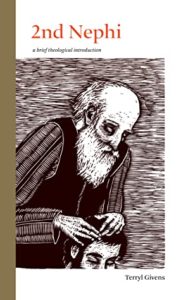 Author: Terryl Givens
Author: Terryl Givens
Title: 2nd Nephi: a brief theological introduction
Neal A. Maxwell Institute, 2020. Paperback
(Reviewed by Dan Call, April 25, 2020)
After Joseph Spencer’s grand slam with 1st Nephi, Givens is up to bat now with his contribution to the “Brief Theological Introductions” to the Book of Mormon series from the Maxwell Institute. Each volume begins with the same concise series introduction, which serves as a baseline from which we can partially evaluate to what degree it accomplishes the larger mission: authors illustrate ways in which we as a church may not yet have grasped the Book of Mormon’s “divine architecture;” an assortment of scholarly and devotional perspectives are marshaled to show us the book’s inexhaustible semiotic capacity; and the aim that these books be a “joint invitation to readers to engage scripture in their own way.”
It was important for me to keep this in mind as I read this second text, since it’s difference in tone and content from the first entry was jarring at times. Givens’ perspective tends towards the cosmic, and he makes the case that 2nd Nephi is intentionally packed with covenant theology, meant to orient individuals and societies toward a relation to God. He does this well, particularly with his clever observation about a glaring fact that most readers never bother to ask: why is there a 2nd book, instead of one continuous narrative? (Side note: polling your own friends and family with this same question is a great exercise in pushing them to think about the writer and his intentions!) Boiling down the answers he’s found is his work in most of the rest of the volume, and the results are fairly convincing: this portion of the Book of Mormon is about reteaching the Lehites their understanding of the Covenant, both correcting some erroneous beliefs they brought from Jerusalem, and reassuring them that, even in the wake of the cataclysmic bombshell their patriarch drops on them, “all is not lost.”
The author’s style would fit in nicely with the best works by Neal A. Maxwell and Hugh Nibley, which is both comforting in it’s towering command of literature, and sometimes disappointing for it’s distance from those of us on the ground. For instance, Mormondom is replete with offshoot groups that seem to reenact the “Jerusalem is destroyed/corrupt, but we have been chosen to carry on the covenant” motif – take the Westover family in “Educated,” for example. In another section, he beautifully explains Lehi’s teachings that sin is it’s own form of punishment (p. 75), but stops short of bringing the implications of this closer to home: how might we use this knowledge to dismantle our cultural and ecclesiastical practice, alive and well in many congregations, of finding, shaming and punishing sinners? But these limitations are at least partially anticipated in the title itself: Brief introductions can only do so much, so we shouldn’t be expecting an exhaustive exposition. And with this in mind, by offering us such a different volume in this series, written in his own hard-earned idiom, Givens accomplishes the task nicely, leaving ample space for the other authors in this stellar lineup to step up and surprise us with their own readings of the keystone of our religion.
